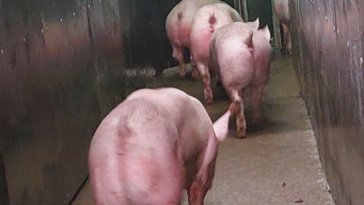PigStun: Presentation & discussion of project results on April 4th

Subject
invitation, pigstun, animal welfare
Target audience
Policy workers, official veterinarians, animal welfare inspectors
The PigStun project started in 2022 with the aim to improve animal welfare during the stunning process of pigs in slaughterhouses. In this European project, researchers and slaughterhouses in Germany, Denmark, Spain and the Netherlands worked together to test alternative stunning methods for pigs to replace conventional CO2 stunning.
The following alternatives were presented:
- Optimised CAS process, in which pre-stunning handling and gas mixture are adjusted in a conventional CO2 system
- Argon Retrofit System, in which the inert gas argon replaces CO2
- Helium Stunning System, in which CO2 is substituted by Helium
- Improved Electric stunning process, in which pigs are stunned in an electric stunning system with an optimised pre-stun handling facility
Details
The meeting started around 9:00, with an opening address by DG SANTEs deputy Director General. Delegates learned about the PigStun results, and engaged in discussions with the researchers about their conclusions and recommendations. The meeting ended at approximately 13:00 hours. A recording of the meeting can be viewed here on DG SANTE’s website.
Program
08:30 - 09:30
Registration and Coffee
09:30 - 09:45
Opening: Deputy Director General DG SANTE
Chair: Hans Spoolder and Andrea Gavinelli
Project introduction and description of the 4 alternative systems in the ‘Pigstun’-project
09:45 - 10:15
The ‘PigStun’ Project: Objectives and description of the alternative systems (Dr. Ing. Marien Gerritzen, Wageningen Livestock Research, The Netherlands)
Results
10:15-10:30
Animal Welfare (Dr. Antonio Velarde, Institute for Food and Agricultural Research and Technology, Spain)
10:30 - 10:45
Meat Quality (Dr. Daniel Lindegaard Hjorth Lund, Danish Meat Research Institute, Denmark)
10:45 - 11:15
Coffebreak
11:15 - 11:30
Social, economic and environmental impacts (Prof. Dr. Jan Tind Sørensen, Aarhus University, Denmark)
11:30 - 11:45
Ease of conversion (Rikke Bonnichsen, Danish Meat Research Institute, Denmark)
11:45 - 12:00
Insights from case slaughterhouses on the alternatives (Prof. Dr. Hanne Kongsted, Aarhus University, Denmark)
Final Conclusions and recommendations
12:00 - 12:15
Conclusions en some recommendations (Dr. Ing. Marien Gerritzen, Wageningen Livestock Research, The Netherlands)
12:15 - 13:00
Discussion
13:00
Closure of the Meeting
Partners

